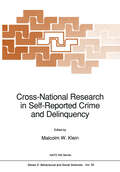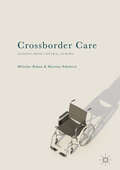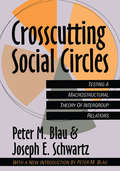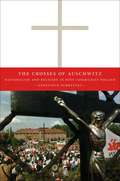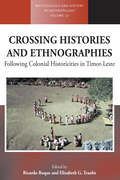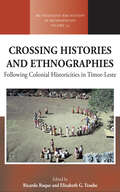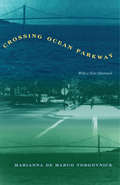- Table View
- List View
Cross-National Research in Self-Reported Crime and Delinquency (NATO Science Series D: #50)
by Malcolm KleinMalcolm W. Klein Center for Research on Crime and Social Control University of Southern California 1. BACKGROUND In June of 1988, approximately forty scholars and researchers met for four days in the Leeuwenborst Congres Center in Noordwijkerhout, The Netherlands, to participate in a workshop entitled Self-Report Metho dology in Criminological Research. The participants represented 15 nations and 30 universities and research centers, a diversity that was matched by the experiences and focal interests in self-report methods among the participants. This volume is the result of the workshop process and in particular of the invitations to participants to prepare pre-conference papers for distribution prior to the workshop. The chapters in the volume were selected from the larger set of pre conference papers. As workshop conv~ner and volume editor, it falls on me to set some of the context for this enterprise. Self-report crime is "admitted" crime, derived from interview and questionnaire responses obtained from adults and juveniles (regardless of whether or not they have been arrested) concerning their own illegal behaviors. Growing awareness of the limitations of official crime statistics has led to the development of self-report procedures.
Crossborder Care: Lessons from Central Europe
by Miloslav Bahna Martina SekulováThis book analyses the circular migration of care workers in Central Europe using the example of Slovak carers in 24-hour care provision for the elderly in Austria. Challenging analyses that focus primarily on care drain and care regimes, Bahna and Sekulová supplement quantitative methodology with qualitative fieldwork to demonstrate the importance of the sending country’s economic context. The authors discuss the dynamics of economic differences between Austria and its post-communist neighbors as preconditions of the crossborder care provision, bridging analyses of policy and legal frameworks with approaches from labor migration study. Even as they scrutinize the relevance of care drain-based analyses, Bahna and Sekulová bring to the fore the interplay of economic differences, social policies, gender and migration regimes with geographic proximity to study long-term impacts of care work, including an analysis of employment after care work.
Crosscutting Social Circles: Testing a Macrostructural Theory of Intergroup Relations
by Peter M. Blau Joseph E. SchwartzCrosscutting Social Circles describes a theory of groups' relations to each other, and tests the theory in the 125 largest metropolitan areas In the United States. The focus is on the Influence social structure exerts on intergroup relations. Blau and Schwartz show how role relations are influenced by how people are distributed among social positions. Examples are a community's racial composition, division of labor, ethnic heterogeneity, income Inequality, or the extent to which educational differences are related to income differences. Blau and Schwartz test their theory by considering its impact on such structural conditions as intermarriage, an important form of intergroup relations.The authors derive the main principles of previously formulated theories of intergroup relations and present them in simpler and clearer form. They empirically test the power of the theory by analyzing its ability to predict how social structure affects intermarriage in the largest American cities, where three-fifths of the American population live. They selected cities because population distribution of a small neighborhood might be affected by casual associations among neighbors; it is much more sociologically interesting if population distribution also affects mate selection in a city of millions.Unlike most theories that emphasize the implications of such cultural orientations as shared values and common norms, this volume focuses on the significance of various forms of inequality and heterogeneity. As one of the few books that supplies a large-scale empirical test of implications of a theory, Crosscutting Social Circles serves as a model. The new introduction by Peter Blau reviews the origins and impact of the book. It will be of immense value to sociologists, psychologists, and group relations specialists.
Crosscutting Social Circles: Testing a Macrostructural Theory of Intergroup Relations
by Peter M. Blau Joseph E. SchwartzCrosscutting Social Circles describes a theory of groups' relations to each other, and tests the theory in the 125 largest metropolitan areas In the United States. The focus is on the Influence social structure exerts on intergroup relations. Blau and Schwartz show how role relations are influenced by how people are distributed among social positions. Examples are a community's racial composition, division of labor, ethnic heterogeneity, income Inequality, or the extent to which educational differences are related to income differences. Blau and Schwartz test their theory by considering its impact on such structural conditions as intermarriage, an important form of intergroup relations.The authors derive the main principles of previously formulated theories of intergroup relations and present them in simpler and clearer form. They empirically test the power of the theory by analyzing its ability to predict how social structure affects intermarriage in the largest American cities, where three-fifths of the American population live. They selected cities because population distribution of a small neighborhood might be affected by casual associations among neighbors; it is much more sociologically interesting if population distribution also affects mate selection in a city of millions.Unlike most theories that emphasize the implications of such cultural orientations as shared values and common norms, this volume focuses on the significance of various forms of inequality and heterogeneity. As one of the few books that supplies a large-scale empirical test of implications of a theory, Crosscutting Social Circles serves as a model. The new introduction by Peter Blau reviews the origins and impact of the book. It will be of immense value to sociologists, psychologists, and group relations specialists.
The Crosses of Auschwitz: Nationalism and Religion in Post-Communist Poland
by Geneviève ZubrzyckiIn the summer and fall of 1998, ultranationalist Polish Catholics erected hundreds of crosses outside Auschwitz, setting off a fierce debate that pitted Catholics and Jews against one another. While this controversy had ramifications that extended well beyond Poland’s borders, Geneviève Zubrzycki sees it as a particularly crucial moment in the development of post-Communist Poland’s statehood and its changing relationship to Catholicism. In The Crosses of Auschwitz, Zubrzycki skillfully demonstrates how this episode crystallized latent social conflicts regarding the significance of Catholicism in defining “Polishness” and the role of anti-Semitism in the construction of a new Polish identity. Since the fall of Communism, the binding that has held Polish identity and Catholicism together has begun to erode, creating unease among ultranationalists. Within their construction of Polish identity also exists pride in the Polish people’s long history of suffering. For the ultranationalists, then, the crosses at Auschwitz were not only symbols of their ethno-Catholic vision, but also an attempt to lay claim to what they perceived was a Jewish monopoly over martyrdom. This gripping account of the emotional and aesthetic aspects of the scene of the crosses at Auschwitz offers profound insights into what Polishness is today and what it may become.
The Crosses of Auschwitz: Nationalism and Religion in Post-Communist Poland
by Geneviève ZubrzyckiIn the summer and fall of 1998, ultranationalist Polish Catholics erected hundreds of crosses outside Auschwitz, setting off a fierce debate that pitted Catholics and Jews against one another. While this controversy had ramifications that extended well beyond Poland’s borders, Geneviève Zubrzycki sees it as a particularly crucial moment in the development of post-Communist Poland’s statehood and its changing relationship to Catholicism. In The Crosses of Auschwitz, Zubrzycki skillfully demonstrates how this episode crystallized latent social conflicts regarding the significance of Catholicism in defining “Polishness” and the role of anti-Semitism in the construction of a new Polish identity. Since the fall of Communism, the binding that has held Polish identity and Catholicism together has begun to erode, creating unease among ultranationalists. Within their construction of Polish identity also exists pride in the Polish people’s long history of suffering. For the ultranationalists, then, the crosses at Auschwitz were not only symbols of their ethno-Catholic vision, but also an attempt to lay claim to what they perceived was a Jewish monopoly over martyrdom. This gripping account of the emotional and aesthetic aspects of the scene of the crosses at Auschwitz offers profound insights into what Polishness is today and what it may become.
The Crosses of Auschwitz: Nationalism and Religion in Post-Communist Poland
by Geneviève ZubrzyckiIn the summer and fall of 1998, ultranationalist Polish Catholics erected hundreds of crosses outside Auschwitz, setting off a fierce debate that pitted Catholics and Jews against one another. While this controversy had ramifications that extended well beyond Poland’s borders, Geneviève Zubrzycki sees it as a particularly crucial moment in the development of post-Communist Poland’s statehood and its changing relationship to Catholicism. In The Crosses of Auschwitz, Zubrzycki skillfully demonstrates how this episode crystallized latent social conflicts regarding the significance of Catholicism in defining “Polishness” and the role of anti-Semitism in the construction of a new Polish identity. Since the fall of Communism, the binding that has held Polish identity and Catholicism together has begun to erode, creating unease among ultranationalists. Within their construction of Polish identity also exists pride in the Polish people’s long history of suffering. For the ultranationalists, then, the crosses at Auschwitz were not only symbols of their ethno-Catholic vision, but also an attempt to lay claim to what they perceived was a Jewish monopoly over martyrdom. This gripping account of the emotional and aesthetic aspects of the scene of the crosses at Auschwitz offers profound insights into what Polishness is today and what it may become.
The Crosses of Auschwitz: Nationalism and Religion in Post-Communist Poland
by Geneviève ZubrzyckiIn the summer and fall of 1998, ultranationalist Polish Catholics erected hundreds of crosses outside Auschwitz, setting off a fierce debate that pitted Catholics and Jews against one another. While this controversy had ramifications that extended well beyond Poland’s borders, Geneviève Zubrzycki sees it as a particularly crucial moment in the development of post-Communist Poland’s statehood and its changing relationship to Catholicism. In The Crosses of Auschwitz, Zubrzycki skillfully demonstrates how this episode crystallized latent social conflicts regarding the significance of Catholicism in defining “Polishness” and the role of anti-Semitism in the construction of a new Polish identity. Since the fall of Communism, the binding that has held Polish identity and Catholicism together has begun to erode, creating unease among ultranationalists. Within their construction of Polish identity also exists pride in the Polish people’s long history of suffering. For the ultranationalists, then, the crosses at Auschwitz were not only symbols of their ethno-Catholic vision, but also an attempt to lay claim to what they perceived was a Jewish monopoly over martyrdom. This gripping account of the emotional and aesthetic aspects of the scene of the crosses at Auschwitz offers profound insights into what Polishness is today and what it may become.
Crossing: Language and Ethnicity among Adolescents (Routledge Linguistics Classics)
by Ben RamptonFocusing on urban youth culture and language crossing, this foundational volume by Ben Rampton has played a pivotal role in the shaping of language and ethnic identity as a domain of study. It focuses on language crossing - the use of Panjabi by adolescents of African-Caribbean and Anglo descent, the use of Creole by adolescents with Panjabi and Anglo backgrounds, and the use of stylized Indian English. Crossing’s central question is: how far and in what ways do these intricate processes of language sharing and exchange help to overcome race stratification and contribute to a new sense of mixed youth, class and neighbourhood community? Ben Rampton produces detailed ethnographic and interactional analyses of spontaneous speech data, and integrates the discussion of particular incidents with theories of discourse, code-switching, social movements, resistance and ritual drawn from sociolinguistics, sociology, anthropology and cultural studies. Now a Routledge Linguistics Classic with a new preface which sets the work in its current context, this book remains key reading for all those working in the areas of applied linguistics, sociolinguistics and linguistic anthropology.
Crossing: Language and Ethnicity among Adolescents (Routledge Linguistics Classics)
by Ben RamptonFocusing on urban youth culture and language crossing, this foundational volume by Ben Rampton has played a pivotal role in the shaping of language and ethnic identity as a domain of study. It focuses on language crossing - the use of Panjabi by adolescents of African-Caribbean and Anglo descent, the use of Creole by adolescents with Panjabi and Anglo backgrounds, and the use of stylized Indian English. Crossing’s central question is: how far and in what ways do these intricate processes of language sharing and exchange help to overcome race stratification and contribute to a new sense of mixed youth, class and neighbourhood community? Ben Rampton produces detailed ethnographic and interactional analyses of spontaneous speech data, and integrates the discussion of particular incidents with theories of discourse, code-switching, social movements, resistance and ritual drawn from sociolinguistics, sociology, anthropology and cultural studies. Now a Routledge Linguistics Classic with a new preface which sets the work in its current context, this book remains key reading for all those working in the areas of applied linguistics, sociolinguistics and linguistic anthropology.
Crossing Borders and Shifting Boundaries: Vol. II: Gender, Identities and Networks (Schriftenreihe der internationalen Frauenuniversität "Technik und Kultur" #11)
by HelenSchwenken ClaudiaSchöning-Kalender MirjanaMorokvasic HelmaLutz IlseLenzThis volume introduces a gender dimension and provides new insights in the issues like nationalism and racism, identity building, transnational networking, citizenship and democracy.
Crossing Boundaries during Peace and Conflict: Transforming identity in Chiapas and in Northern Ireland (The Politics of Intersectionality)
by M. HoewerThe book takes the reader into the world of women who become actively involved in various mobilization processes in the peace and conflict situations in Chiapas and in Northern Ireland. Detailing how women cross identity boundaries in regions of conflict, the book combines traditional and qualitative research methods in groundbreaking new research.
Crossing Broadway: Washington Heights and the Promise of New York City
by Robert W. SnyderRobert W. Snyder's Crossing Broadway tells how disparate groups overcame their mutual suspicions to rehabilitate housing, build new schools, restore parks, and work with the police to bring safety to streets racked by crime and fear. It shows how a neighborhood once nicknamed "Frankfurt on the Hudson" for its large population of German Jews became "Quisqueya Heights"—the home of the nation's largest Dominican community.The story of Washington Heights illuminates New York City's long passage from the Great Depression and World War II through the urban crisis to the globalization and economic inequality of the twenty-first century. Washington Heights residents played crucial roles in saving their neighborhood, but its future as a home for working-class and middle-class people is by no means assured. The growing gap between rich and poor in contemporary New York puts new pressure on the Heights as more affluent newcomers move into buildings that once sustained generations of wage earners and the owners of small businesses.Crossing Broadway is based on historical research, reporting, and oral histories. Its narrative is powered by the stories of real people whose lives illuminate what was won and lost in northern Manhattan's journey from the past to the present. A tribute to a great American neighborhood, this book shows how residents learned to cross Broadway—over the decades a boundary that has separated black and white, Jews and Irish, Dominican-born and American-born—and make common cause in pursuit of one of the most precious rights: the right to make a home and build a better life in New York City.
Crossing Cultural Borders: Education for Immigrant Families in America (Routledge Library Editions: Immigration and Migration #6)
by Concha Delgado-Gaitan Henry TruebaCrossing Cultural Borders (1991) examines the day-to-day interaction of immigrant children with adults, siblings and peers in the home, school and community at large as these families demonstrate their skill in using their culture to survive in a new society. Children of Mexican and Central American immigrant families in Secoya crossed a national border, and continue to cross linguistic, social and cultural borders that separate the home, school and outside world.
Crossing Cultural Borders: Education for Immigrant Families in America (Routledge Library Editions: Immigration and Migration #6)
by Concha Delgado-Gaitan Henry TruebaCrossing Cultural Borders (1991) examines the day-to-day interaction of immigrant children with adults, siblings and peers in the home, school and community at large as these families demonstrate their skill in using their culture to survive in a new society. Children of Mexican and Central American immigrant families in Secoya crossed a national border, and continue to cross linguistic, social and cultural borders that separate the home, school and outside world.
Crossing Fandoms: SuperWhoLock and the Contemporary Fan Audience
by Paul BoothThis book examines the fan-created combination of Doctor Who, Sherlock, and Supernatural as a uniquely digital fan experience, and as a metaphor for ongoing scholarship into contemporary fandom. What do you get when you cross the cult shows Doctor Who, Supernatural, and Sherlock? In this book, Paul Booth explores the fan-created crossover universe known as SuperWhoLock—a universe where Sherlock Holmes and Dean Winchester work together to fight monsters like the Daleks and the Weeping Angels; a world where John Watson is friends with Amy Pond; a space where the unique brands of fandom interact. Booth argues that SuperWhoLock represents more than just those three shows—it is a way of doing fandom. Through interviews with fans and analysis of fan texts, Crossing Fandoms: SuperWhoLock and the Contemporary Fan Audience also demonstrates how fan studies in the digital age can evolve to take into account changing fan activities and texts.
Crossing Histories and Ethnographies: Following Colonial Historicities in Timor-Leste (Methodology & History in Anthropology #37)
by Ricardo Roque and Elizabeth G. TraubeThe key question for many anthropologists and historians today is not whether to cross the boundary between their disciplines, but whether the idea of a disciplinary boundary should be sustained. Reinterpreting the dynamic interplay between archive and field, these essays propose a method for mutually productive crossings between historical and ethnographic research. It engages critically with the colonial pasts of indigenous societies and examines how fieldwork and archival studies together lead to fruitful insights into the making of different colonial historicities. Timor-Leste’s unusually long and in some ways unique colonial history is explored as a compelling case for these crossings.
Crossing Histories and Ethnographies: Following Colonial Historicities in Timor-Leste (Methodology & History in Anthropology #37)
by Ricardo Roque and Elizabeth G. TraubeThe key question for many anthropologists and historians today is not whether to cross the boundary between their disciplines, but whether the idea of a disciplinary boundary should be sustained. Reinterpreting the dynamic interplay between archive and field, these essays propose a method for mutually productive crossings between historical and ethnographic research. It engages critically with the colonial pasts of indigenous societies and examines how fieldwork and archival studies together lead to fruitful insights into the making of different colonial historicities. Timor-Leste’s unusually long and in some ways unique colonial history is explored as a compelling case for these crossings.
Crossing Histories and Ethnographies: Following Colonial Historicities in Timor-Leste (Methodology & History in Anthropology #37)
by Ricardo Roque Elizabeth G. TraubeThe key question for many anthropologists and historians today is not whether to cross the boundary between their disciplines, but whether the idea of a disciplinary boundary should be sustained. Reinterpreting the dynamic interplay between archive and field, these essays propose a method for mutually productive crossings between historical and ethnographic research. It engages critically with the colonial pasts of indigenous societies and examines how fieldwork and archival studies together lead to fruitful insights into the making of different colonial historicities. Timor-Leste’s unusually long and in some ways unique colonial history is explored as a compelling case for these crossings.
Crossing Histories and Ethnographies: Following Colonial Historicities in Timor-Leste (Methodology & History in Anthropology #37)
by Ricardo Roque Elizabeth G. TraubeThe key question for many anthropologists and historians today is not whether to cross the boundary between their disciplines, but whether the idea of a disciplinary boundary should be sustained. Reinterpreting the dynamic interplay between archive and field, these essays propose a method for mutually productive crossings between historical and ethnographic research. It engages critically with the colonial pasts of indigenous societies and examines how fieldwork and archival studies together lead to fruitful insights into the making of different colonial historicities. Timor-Leste’s unusually long and in some ways unique colonial history is explored as a compelling case for these crossings.
Crossing Ocean Parkway
by Marianna De TorgovnickGrowing up an Italian-American in the Bensonhurst neighborhood of New York city, Marianna De Marco longed for college, culture, and upward mobility. Her daydreams circled around WASP (White Anglo Saxon Protestant) heroes on television—like Robin Hood and the Cartwright family—but in Brooklyn she never encountered any. So she associated moving up with Ocean Parkway, a street that divides the working-class Italian neighborhood where she was born from the middle-class Jewish neighborhood into which she married. This book is Torgovnick's unflinching account of crossing cultural boundaries in American life, of what it means to be an Italian American woman who became a scholar and literary critic. Included are autobiographical moments interwoven with engrossing interpretations of American cultural icons from Dr. Dolittle to Lionel Trilling, The Godfather to Camille Paglia. Her experiences allow her to probe the cultural tensions in America caused by competing ideas of individuality and community, upward mobility and ethnic loyalty, acquisitiveness and spirituality.
Crossing Ocean Parkway
by Marianna De TorgovnickGrowing up an Italian-American in the Bensonhurst neighborhood of New York city, Marianna De Marco longed for college, culture, and upward mobility. Her daydreams circled around WASP (White Anglo Saxon Protestant) heroes on television—like Robin Hood and the Cartwright family—but in Brooklyn she never encountered any. So she associated moving up with Ocean Parkway, a street that divides the working-class Italian neighborhood where she was born from the middle-class Jewish neighborhood into which she married. This book is Torgovnick's unflinching account of crossing cultural boundaries in American life, of what it means to be an Italian American woman who became a scholar and literary critic. Included are autobiographical moments interwoven with engrossing interpretations of American cultural icons from Dr. Dolittle to Lionel Trilling, The Godfather to Camille Paglia. Her experiences allow her to probe the cultural tensions in America caused by competing ideas of individuality and community, upward mobility and ethnic loyalty, acquisitiveness and spirituality.
Crossing Ocean Parkway
by Marianna De TorgovnickGrowing up an Italian-American in the Bensonhurst neighborhood of New York city, Marianna De Marco longed for college, culture, and upward mobility. Her daydreams circled around WASP (White Anglo Saxon Protestant) heroes on television—like Robin Hood and the Cartwright family—but in Brooklyn she never encountered any. So she associated moving up with Ocean Parkway, a street that divides the working-class Italian neighborhood where she was born from the middle-class Jewish neighborhood into which she married. This book is Torgovnick's unflinching account of crossing cultural boundaries in American life, of what it means to be an Italian American woman who became a scholar and literary critic. Included are autobiographical moments interwoven with engrossing interpretations of American cultural icons from Dr. Dolittle to Lionel Trilling, The Godfather to Camille Paglia. Her experiences allow her to probe the cultural tensions in America caused by competing ideas of individuality and community, upward mobility and ethnic loyalty, acquisitiveness and spirituality.
Crossing Ocean Parkway
by Marianna De TorgovnickGrowing up an Italian-American in the Bensonhurst neighborhood of New York city, Marianna De Marco longed for college, culture, and upward mobility. Her daydreams circled around WASP (White Anglo Saxon Protestant) heroes on television—like Robin Hood and the Cartwright family—but in Brooklyn she never encountered any. So she associated moving up with Ocean Parkway, a street that divides the working-class Italian neighborhood where she was born from the middle-class Jewish neighborhood into which she married. This book is Torgovnick's unflinching account of crossing cultural boundaries in American life, of what it means to be an Italian American woman who became a scholar and literary critic. Included are autobiographical moments interwoven with engrossing interpretations of American cultural icons from Dr. Dolittle to Lionel Trilling, The Godfather to Camille Paglia. Her experiences allow her to probe the cultural tensions in America caused by competing ideas of individuality and community, upward mobility and ethnic loyalty, acquisitiveness and spirituality.
Crossing Ocean Parkway
by Marianna De TorgovnickGrowing up an Italian-American in the Bensonhurst neighborhood of New York city, Marianna De Marco longed for college, culture, and upward mobility. Her daydreams circled around WASP (White Anglo Saxon Protestant) heroes on television—like Robin Hood and the Cartwright family—but in Brooklyn she never encountered any. So she associated moving up with Ocean Parkway, a street that divides the working-class Italian neighborhood where she was born from the middle-class Jewish neighborhood into which she married. This book is Torgovnick's unflinching account of crossing cultural boundaries in American life, of what it means to be an Italian American woman who became a scholar and literary critic. Included are autobiographical moments interwoven with engrossing interpretations of American cultural icons from Dr. Dolittle to Lionel Trilling, The Godfather to Camille Paglia. Her experiences allow her to probe the cultural tensions in America caused by competing ideas of individuality and community, upward mobility and ethnic loyalty, acquisitiveness and spirituality.
